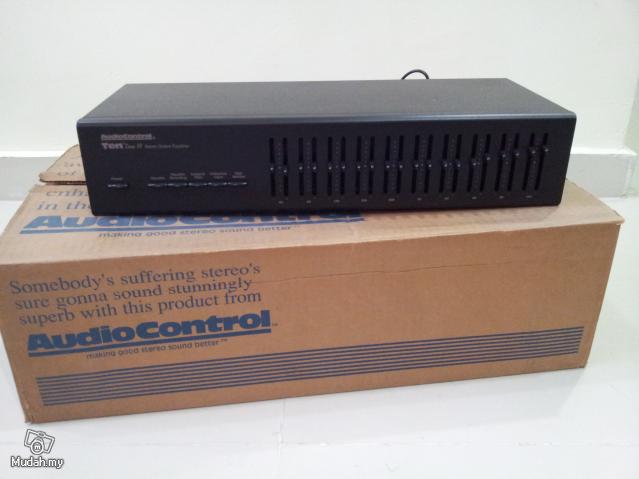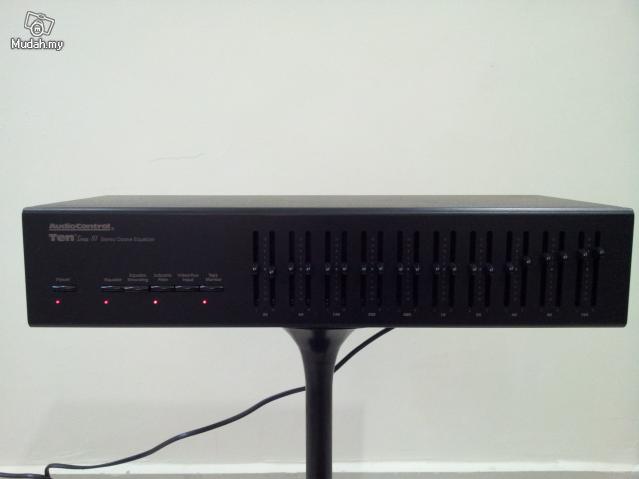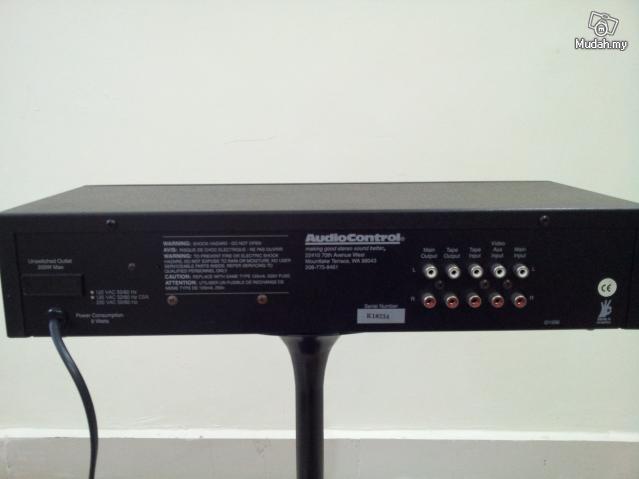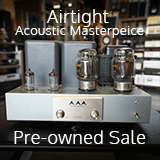AudioControl Ten Series 3 USA Made stereo octave equalizer (sold
Hi-Fi 4 Sale - Malaysia / Singapore Audio Forum & Marketplace | www.hifi4sale.net :: Audio & Video Equipment Marketplace :: Audio & Video Equipment: FOR SALE (Pre-owned & Used)
Page 1 of 1
 AudioControl Ten Series 3 USA Made stereo octave equalizer (sold
AudioControl Ten Series 3 USA Made stereo octave equalizer (sold



Made In America, USA
Congratulations on having the good taste to buy one of the world's finest octave equalizers for your home stereo.
Now you can improve the performance of your speakers, adjust the sound of CD's, make killer car tapes and even improve the sound of video soundtracks.
The TEN is a fairly complex, high performance add-on with lots of buttons, knobs and sockets including some not found on any other equalizer, so face the blackboard and we'll run you through each control, hole and protuberance on the TEN
Note : Below are some Technical Description ( Very Boring)
Simply Say, If u want to Upgrade Sound for ur existing HI FI System. This is the Simple Solution without Burning a Big Hole in ur Pocket.
Sound Amazing
Limited New Old Stock Available.
Description :
POWER SWITCH
Self explanatory. It allows the TEN to nourish its circuits from the vast dynamos and generators of your local monopolistic power company. Don't worry about using a splitter socket if you're short of outlets: The TEN draws less current than a clock radio and will pose no overload hazard when added to your current tangle of plugs.
EQ SWITCH
Think of this as a comparison switch. IN, you're hearing the effect of the TEN. OUT, you're hearing things as they were before the TEN was installed. When you use the TEN to change the tone of your music or beef up speaker range, just pop the EQ switch in and out to make frequency comparisons.
EQUALIZE RECORDING
This switch determines whether you're equalizing your program source (CD, FM etc.) onto tape or not. In the OUT position, your program source is simply being equalized and played through your speakers. The IN setting transfers all the equalization to your tape deck. Just about all cassette recordings can benefit by equalization which we'll cover further on. Note that the LED under the EQUALIZE RECORDING button blinks on the IN position to warn you in case you DON'T want to equalize a recording.
SUBSONIC FILTER
Subsonics are inaudible ultra-low frequency oscillations caused by feed- back, floor vibration, studio noise and other nefarious enemies of your speakers. They manifest themselves in a visible flopping of speaker woofer cones. Distorting and destructive, subsonics are chopped off below 20Hz by this special filter circuit. Don't confuse it with the lousy "Low Cut" filter on your receiver or integrated which also robs audible low bass. The SUBSONIC filter on the TEN should be left IN at all times with no audible loss of bass and a whole lot of positive speaker protection.
VIDEO/AUXILIARY
Both this button and the TAPE MON button next door allow you to play different inputs into the equalizer and then into your receiver or preamp for listening. When you press VIDEO/AUX IN, the TEN will be equalizing input from a television, disc player, VCR or any other line level source. TAPE MONITOR This is a "loop" just like the one controlled by the Tape Monitor on your receiver. When pushed in, the TEN is receiving signals from the tape decks. Note that if the deck is not playing and the TAPE MON button is pushed in, deafening silence will occur. Since the TAPE MON is a loop which goes out of the TEN through a tape deck or other device and back in, it is where you'd plug any other sound- enhancing devices such as surround sound, noise reducers, expanders, etc. If such a device is installed, pushing the TAPE MON button IN will activate this device. See the hook-up details if this is getting hazy. If you don't own any other outboard add-ons, don't worry about it further. Next we come to the
EQ SLIDERS
that make up the equalization portion of the TEN. The sound spectrum - from the lowest to highest - is divided up into ten EQUAL ranges, called octaves. Don't worry about the fact that the frequency numbers don't jump up in orderly tenths but instead approximately double. Just think of them as ten equal bands of sound. Each has its purposes and contributes different experiences to your enjoyment of music. While reading this section, note the chart of instruments which will help you understand the relationships of instruments to frequency bands.
31.5 Hz, 63 Hz, 125 Hz, 250 Hz: THE SLIDERS THAT SHOOK THE WORLD! The four bottom sliders on your TEN roughly correspond to the bass control on your amp or receiver - or rather we should say that your receiver's bass tone control is what's rough. 31.5 Hz. Truly a piece of the rock. This lowest of lows is what you've always wanted more of. It's the frequency that you feel as well as hear. The frequency that kicks you live at concerts. Unfortunately, the whole signal chain conspires to remove it. Even $1000 microphones are not flat that low; studio recorders roll off in this area. It's hard to master and pretty near impossible for most speaker woofers to reproduce. So, even if you run the 31.5Hz slider up to +15Hz, your speakers will probably be 5dB or more down at this gutrocking frequency. Lay it on thick, if you have the amp power to handle it. 63Hz. Here's the bass you were after when you used to turn on the loudness or bass tone control. It's the deep, tight,strong bass that makes rock solid. It's also where most speaker systems start giving out, as you probably saw when you response-analyzed your speakers and room. But, if it didn't take a lot to flatten the response of your system, feel free to add some more. Most studio producers and engineers actually cut down on this frequency to compensate for teeny radios and bubblegummers' cheap compact stereos, so adding some 63Hz is not "gonna be no sin," as B.B. King put it. It's the slider that makes the bass drums and floor toms "bigger" and broadens bass guitar parts. And, even does surprising things to operatic basso voices. (Forget it on Neil Young's, though.) 125Hz. This is the bass that jukeboxes and cheap stereos specialize in. Ithas a boom quality that can get very tiresome to the ears after a while. That's not to knock it. Push the 125Hz slider to MINUS 5dB and you'll find a lot of what you might have thought was bass will be gone. You see, if 31.5Hz and 63Hz were the flour and eggs of a cake, the 125Hz band is the vanilla extract and sugar - the flavoring of bass. Boosting it too high is like guzzling straight extract and sugar syrup. Use 125Hz sparingly, as a seasoning, the way producers do. Maybe +3 to pump up a vocal or a bass guitar part. A bit more if you're a drum freak. Also good for acoustic bass, virtually all symphonic music and your Aunt Tillie's goiter. 250Hz. This is on the upper fringes of bass. Fiddle with it and you'll see it has relatively little to do with bass guitar or kick drum. It does have a lot to do with voices and lead guitar solos, though. Without it they lack body. Add 250Hz to "flesh out" thin vocals or older records with narrower dynamic ranges.
BRINGING THEM FORWARD AND MOVING THEM BACK: 500, 1000, 2000, 4000 These sliders control the core of music. Melody instruments, vocals, midrange percussion - almost everything we associate with music. With care, you can substantially change the sound of most melody instruments as well as vocals. Each cut and album will be different, so experiment. In our experience the 1000 slider does most for all-around human voice presence. 500 is great for male voices and jazz tenor saxes. Some solo piano benefits by a little boost here, too. In practice, folks seem to cut down the 2000 and 4000 as much as they boost them. There seems to be plenty of these frequencies in most contempo- rary pop cuts. The question is, is there too much? Particularly at high sound pressure levels. Try it for yourself.
GETTING VERY HIGH: 8000 and 16000. Oddly enough, neither of these frequencies is as ear-piercing as you might think. What you thought was tinny treble is really lower down at 2000 and 4000. Up at 2000 you'll be surprised how few instruments are actually affected. The tips of womens' vocals, snare drums, some synthesizer and higher brass and woodwinds. But you can use more of it than you might first suppose by its classification as "treble." As for the 16Hz, well, it's the icing on that audio cake we were describing earlier. The crisp sizzling of cymbals, the high harmonic overtones that bring music to life...they're all here. Unfortunately, this is also a frequency which involves (dare we bring it up?) your age. From young adolescence on we start to lose the high end of our hearing. It's the ultimate finito frequency roll-off and there's little that can be done about it. Not that we're saying you are getting deaf when you reach 30. But you can hear less 16K than you could ten years ago. That's all. Boosting this band 3-5dB can "flatten" your hearing curve again and bring a lot out. Just don't get vain and leave it at 0dB.
Price : RM s9ld
Contact Simon Ting 012-3612507
Last edited by HiFiLab on Wed Feb 25, 2015 10:25 pm; edited 1 time in total (Reason for editing : sold)
HiFiLab- Dealer\Reseller\Trader\Service Provider

- Number of posts : 2967
Age : 44
Location : klang
Registration date : 2011-03-12
Character sheet
Source(s):
Amplification:
Speakers:
 BUMP
BUMP
UP
HiFiLab- Dealer\Reseller\Trader\Service Provider

- Number of posts : 2967
Age : 44
Location : klang
Registration date : 2011-03-12
Character sheet
Source(s):
Amplification:
Speakers:
 BUMP
BUMP
UP
HiFiLab- Dealer\Reseller\Trader\Service Provider

- Number of posts : 2967
Age : 44
Location : klang
Registration date : 2011-03-12
Character sheet
Source(s):
Amplification:
Speakers:
 Similar topics
Similar topics» Audiocontrol TEN series III stereo octave equalizer SOLD
» Octave RE290 stereo power amp + super black box (Sold)
» TAG McLaren Audio F3 Series 60I SL England Made Stereo Integrated Ampifier
» NAD Monitor Series 1600 Stereo Preamp Tuner and 2700 Stereo Power amplifier (Used) SOLD
» Sansui SE2000 stereo graphic equalizer sold
» Octave RE290 stereo power amp + super black box (Sold)
» TAG McLaren Audio F3 Series 60I SL England Made Stereo Integrated Ampifier
» NAD Monitor Series 1600 Stereo Preamp Tuner and 2700 Stereo Power amplifier (Used) SOLD
» Sansui SE2000 stereo graphic equalizer sold
Hi-Fi 4 Sale - Malaysia / Singapore Audio Forum & Marketplace | www.hifi4sale.net :: Audio & Video Equipment Marketplace :: Audio & Video Equipment: FOR SALE (Pre-owned & Used)
Page 1 of 1
Permissions in this forum:
You cannot reply to topics in this forum








